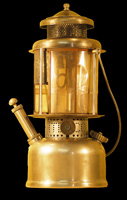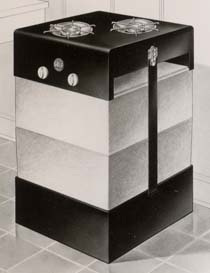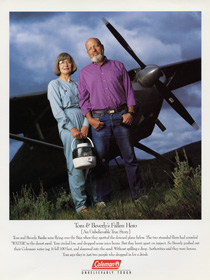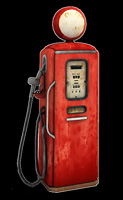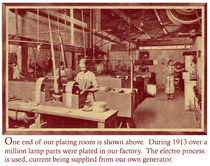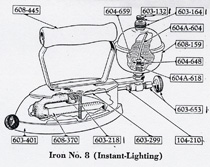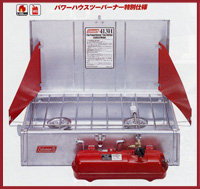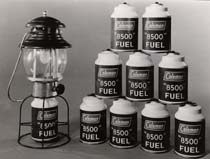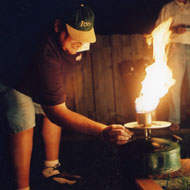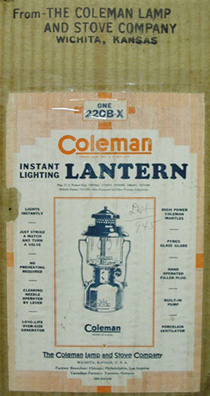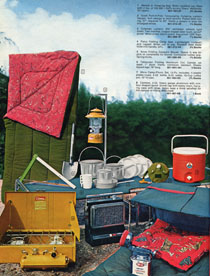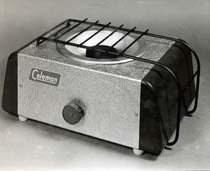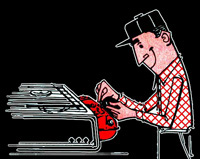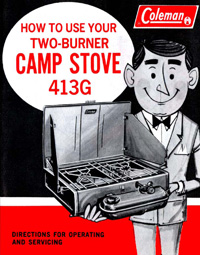 Rebuilding Coleman® Single Burner Stoves
Rebuilding Coleman® Single Burner Stoves
Chapter Two: Cleaning
The sequence of cleaning parts is not important, but we will start with items that will take a little longer to finish.
2.1 Clean the small parts. Separate nickel-plated parts from brass, steel and aluminum ones and clean them separately. Nickel plate can be damaged by acids and you should use caution when using them.
If you wish to clean the soot, dirt and varnish off your stove parts, I recommend using a bead-blast cabinet, soaking them in white vinegar (acetic acid) or in naval jelly (phosphoric and sulfuric acid). Since most people do not have a bead-blast cabinet in their garage, I will use chemicals for this example.
 Acids can burn you. Please use with caution and read the manufacturer’s warning labels before using. Click here to access our Safety Data Sheet (SDS) pages for additional information.
Acids can burn you. Please use with caution and read the manufacturer’s warning labels before using. Click here to access our Safety Data Sheet (SDS) pages for additional information.
White vinegar is the easiest way to clean parts. It may take some time, but it works well. Using naval jelly is faster but it is also quite messy. Both vinegar and naval jelly will damage nickel plate if allowed to sit too long.
![]()
If you are working on a #500 stove and the burner and grate is excessively rusty, I recommend using electrolysis to clean it. You can find instructions on this cleaning method here.
I strongly recommend that you do not soak the regulator stem in vinegar. The stem packing is inside and submerging it in a liquid can cause damage. Clean this part with naval jelly, or just use a metal brush and carburetor cleaner on it.
The stove's pump handle and cap are probably nickel plated. You can clean them with vinegar or naval jelly as described below, just use caution. Do not use a wire brush on the pump cap.
Place your selected parts in a glass or plastic container, then pour in enough vinegar to submerge them as shown in Figure 1. Allow them to soak for an hour or so. If you coat them with naval jelly, allow 30 minutes for cleaning.
Brush naval jelly on to the parts selected for this method as shown in Figure 2. Allow them to sit covered with naval jelly for 30 minutes or so.
Remove the parts from the vinegar and/or naval jelly bath and rinse them with water. Take a small brass or wire brush and scrub each part well. Rinse again with water and clean them with a rag. If you want a shine on the brass, use 0000 steel wool after cleaning. Parts cleaned with naval jelly will not have the pinkish hue that vinegar will give you.
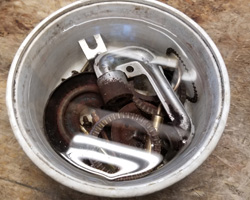 |
 |
Figure 1 |
Figure 2 |
2.2 Clean the pump assembly. Lay out the pieces of your pump. Remove the dirt and grime with an old toothbrush, then use a soft rag to clean each piece.
Pay special attention to the pump cap. Use a toothbrush and cotton swabs to clean the inside. Be persistent to remove the dark ring around the center hole. Do not use a metal brush as you will remove the thin plating material.
2.3 Reassemble the pump assembly. Slide the pump cap and spring on the pump plunger. Place the backing plate on the bottom of the shaft with the raised side facing the bottom. Snug with pliers.
Place the pump cup on the end of the pump. Center the shaft in the leather hole and install the lock nut or push-on nut over it. Pull the outer edges of the pump cup back to form the shape of an umbrella (Figure 3).
Lower the pump cup down into a small cup of Neatsfoot, or a light motor oil. Ensure that the entire leather cup is submerged in oil (Figure 4). Allow the pump to soak while you are cleaning the rest of the stove.
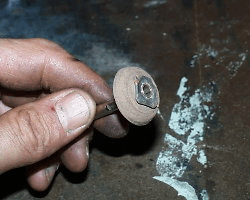 |
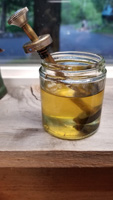 |
Figure 3 |
Figure 4 |
2.4 Clean the fuel and air tube. Lay the fuel and air tube, spring and metering rod on a cloth. Hold the tube with one hand and spray carburetor cleaner into the large end (Figure 5). Take the metering rod and insert it backwards, up from the bottom of the tube (Figure 6). Move it in and out numerous times to dislodge any varnish inside the tube. Remove the rod and re-spray inside the tube. Repeat this process a few times to ensure it is clean.
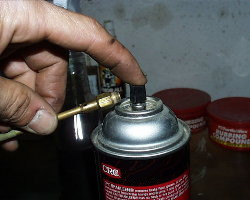 |
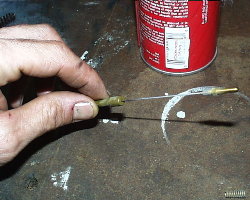 |
Figure 5 |
Figure 6 |
If you have an air compressor, blow air into the little end to remove the cleaner and corrosion. If you don't, shake the tube with the large end down to remove as much cleaner as you can, then blow through the tube from the little end as hard as you can.
Clean the Metering Rod with steel wool (Figure 7) and then wipe it off with a clean rag. Because the Spring in the Fuel and Air Tube is normally compressed, it will lose tension over time and weaken. By stretching the spring (just a little bit!) we can restore the tension. Simply pull on both ends to expand it, just enough to see a noticeable gain in length.
Now put the spring on the rod and slide them in the tube, just like they are when in use (Figure 8). Press down on the top of the metering rod to observe how it travels inside the tube. The metering rod should go down without binding, and the spring should push it back up without binding.
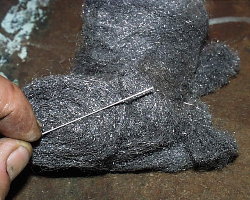 |
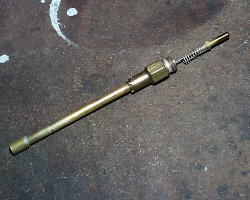 |
Figure 7 |
Figure 8 |
2.5 Clean inside of the fount. Fill the fount with hot water and shake it around. Observe the water as you pour it out. If you can see dirt or rust in the water, continue the wash cycle until it comes out clear.
Shake the fount vigorously, removing as much water as possible from the inside. Shine a flashlight into the fuel hole and look in the fuel filler cap hole at the inside-bottom of your fount. A clean fount will look like bare metal or have a cream-colored painted look to it. If you can see heavy rust or a black crud inside, use abrasion and/or vinegar to break it free.
The “abrasive” can be small screws, nuts, washers, BBs, etc. Pour these small metal objects into your fount and shake them around. Shake hard enough to break the corrosion free, but not so hard that you leave dimples.
Continue to wash, shake and rinse until the inside of the fount is clean and as rust-free as you can get it. Shake vigorously one last time to remove most of the water. Pour some stove alcohol in the fount and shake it around, then allow it to completely air-dry.
2.6(a) Clean the outside of a (painted) fount. Removing dirt, grime and oxidation from a stove's paint job is no different than if it was an old car. You must use caution, however, as rubbing compound is abrasive and you can rub too much.
This is particularly true if you have a decal on your stove. Rubbing compound can take the ink right off the decal and leave it white. I strongly recommend you not rub on the decal with anything more than a spray cleaner and your finger.
Start by spraying the fount down with a household cleaner as shown in Figure 9. Be sure to spray the inside of the pump cylinder too. Give everything a good soaking. Take a soft damp rag and gently remove as much dirt and grime as you can. If you have a heavy black deposit (varnish) somewhere on your Fount, take your time and get it off with cleaner.
Use a toothbrush to scrub the inside of the cylinder until it feels smooth. Hold the fount upside-down and spray the cleaner up inside to rinse the grime out.
Open a can of automotive rubbing compound and spray in some cleaner to soften it up (Figure 10). Rubbing compound is very abrasive so use it sparingly until you can see how it is working.
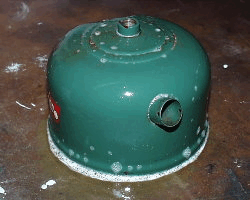 |
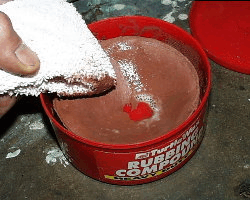 |
Figure 9 |
Figure 10 |
Lightly dab an old toothbrush into the rubbing compound and use it to clean around the fuel filler hole and the pump cylinder hole. Use a soft damp rag and a circular motion to apply rubbing compound to the rest of the fount.
With a clean soft rag, rub the dried rubbing compound off the fount and buff to a shine. If the compound does not want to come off, give it a quick spray of cleaner and try again. Use a dry brush for the pump cylinder and filler hole. Follow this with polishing car wax to really make the fount shine.
2.6(b) Clean the outside of a (plated) fount. Nickel plated stoves that have been exposed to the elements are often dull and sometimes are rough to the touch. Nickel is not as durable as you may think and lengthy exposure to dirt and moisture often damages it.
Don't forget to add the nickeled parts of your stove to this cleaning process.
Start by spraying the fount down with a household cleaner. Be sure to spray the inside of the pump cylinder too. Give everything a good soaking. Take a soft damp rag and gently remove as much dirt and grime as you can. If you have heavy black deposits (varnish) spots on the fount, take your time and get them off with cleaner. Use a toothbrush to scrub the inside of the pump cylinder until it feels smooth.
![]() Caution: You can destroy a nickel finish with corrosives if you’re not careful. Don’t allow any nickeled part to soak for more than 10 minutes at any one time. Rinse the corrosive off each piece with warm water when you are finished.
Caution: You can destroy a nickel finish with corrosives if you’re not careful. Don’t allow any nickeled part to soak for more than 10 minutes at any one time. Rinse the corrosive off each piece with warm water when you are finished.
If your nickel has a little shine but appears to have a haze over it, this will often times come clean with a soft cloth and vinegar, followed by good hand-polishing with a metal polish as shown in Figure 11.
If the nickel is dull and feels rough, you can clean it up a bit using a product like Lime-a-Way® or CLR®. Personally, I prefer Lime-a-Way® because it is gooey and sticks to the nickel well. Use whatever cleaner you like, just remember that it can destroy the plating if you don’t use caution.
Pour the cleaner on the fount and completely cover it with a generous layer. Allow it to set for not more than 15 minutes. Gently rub with a soft rag or sponge. You can repeat this process as many times as necessary but remember that excessive exposure to the cleaner can destroy the nickel. Once you have cleaned the fount, rinse well with warm water to remove the cleaner and allow it to dry.
A fount that feels rough usually has lost some nickel. Once you clean it you may have brass spots showing though.
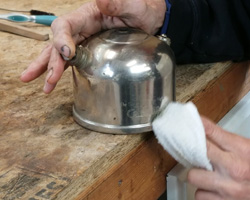 |
Figure 11 |
Shine your nickel-plated parts by hand. I have used numerous metal cleaners and polishes with similar results. Metal polish will not necessarily bring back the original luster of the nickel, but it sure will look good. Figures 12, 13 and 14 were all cleaned and shined with the processes described above.
 |
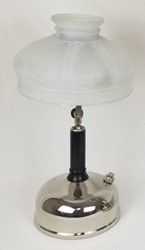 |
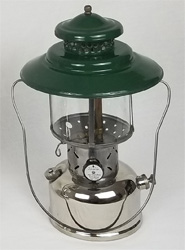 |
Figure 12 |
Figure 13 |
Figure 14 |
2.7 Clean the fuel filler cap. The original cap should match your fount, either plated or painted. Clean the cap (and screw if applicable) as you did the fount. I recommend you always use a new fuel filler cap when operating any stove or lantern. If you would like instructions on how to remove and replace the filler cap gasket please click here.
2.8 Clean the valve wheel and direction disc. Set the valve wheel and direction disc down on your workbench and soak them with household cleaner. Hold the direction disc in the palm of your hand and gently rub the face of it with your fingers. Do not rub hard as the lettering will come off. If some of the dirt is too hard to remove, leave it alone. Use a toothbrush to clean the valve wheel, paying attention to the groove where the disc sits.
2.9 Clean the filler rings. Take a pad of steel wool and lightly clean both sides of each filler ring. Wipe them off with a rag.
2.10 Rust protection. Because some of your stove parts are steel, they are susceptible to rust. These parts leave the factory painted but the paint is usually lost after years of use. If you want to, paint the following parts with a high-temperature silver paint: inner burner bowl, burner cap, burner screws and the Bunsen.
Your stove is now clean and ready for re-assembly.


